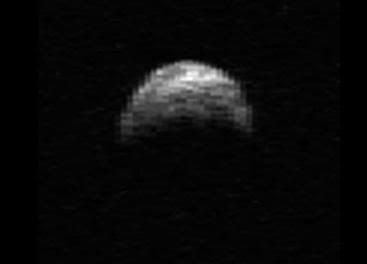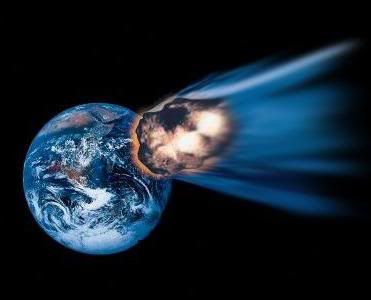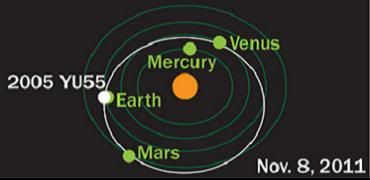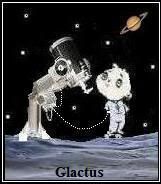Post by glactus on Nov 8, 2011 1:53:41 GMT
A huge asteroid will pass closer to Earth than the moon this week, giving scientists a rare chance for study without having to go through the time and expense of launching a probe, say experts. Earth's close encounter with Asteroid 2005 YU 55 will occur at 10am Wednesday AEDT (2328 GMT Tuesday), as the space rock sails about 323,469 kilometres from the planet.

Asteroid 2005 YU 55
The orbit and position of the asteroid, which is about 400 metres in diameter, is well known, added senior research scientist Don Yeomans, with NASA's Jet Propulsion Laboratory, in Pasadena, California."There is no chance that this object will collide with the Earth or moon," says Yeomans.

The Asteroid near Earth
Thousands of amateur and professional astronomers are expected to track YU 55's approach, which will be visible from the planet's northern hemisphere. It will be too dim to be seen with the naked eye, however, and it will be moving too fast for viewing by the Hubble Space Telescope
.
The orbit of Asteroid 2005 YU 55
"It is going to be very faint, even at its closest approach. You will need a decent-sized telescope to be able to actually see the object as it flies by," says Yeomans.
Scientists suspect YU 55 has been visiting Earth for thousands of years, but because gravitational tugs from the planets occasionally tweak its path, they cannot tell for sure how long the asteroid has been in its present orbit.
Computer models showing the asteroid's path for the next 100 years show there is no chance it will hit Earth during that time, adds Yeomans.
"We do not think that it will ever impact the Earth or moon but we only have its orbit calculated for the next 100 years," he says.

Credits: These are non copywrite images
Text: This is part text only. See full text and all scientists involved at Space Daily.com
www.spacedaily.com/reports/NASA_in_Final_Preparations_for_Nov_8_Asteroid_Flyby_999.html

Asteroid 2005 YU 55
The orbit and position of the asteroid, which is about 400 metres in diameter, is well known, added senior research scientist Don Yeomans, with NASA's Jet Propulsion Laboratory, in Pasadena, California."There is no chance that this object will collide with the Earth or moon," says Yeomans.

The Asteroid near Earth
Thousands of amateur and professional astronomers are expected to track YU 55's approach, which will be visible from the planet's northern hemisphere. It will be too dim to be seen with the naked eye, however, and it will be moving too fast for viewing by the Hubble Space Telescope
.

The orbit of Asteroid 2005 YU 55
"It is going to be very faint, even at its closest approach. You will need a decent-sized telescope to be able to actually see the object as it flies by," says Yeomans.
Scientists suspect YU 55 has been visiting Earth for thousands of years, but because gravitational tugs from the planets occasionally tweak its path, they cannot tell for sure how long the asteroid has been in its present orbit.
Computer models showing the asteroid's path for the next 100 years show there is no chance it will hit Earth during that time, adds Yeomans.
"We do not think that it will ever impact the Earth or moon but we only have its orbit calculated for the next 100 years," he says.
Credits: These are non copywrite images
Text: This is part text only. See full text and all scientists involved at Space Daily.com
www.spacedaily.com/reports/NASA_in_Final_Preparations_for_Nov_8_Asteroid_Flyby_999.html


